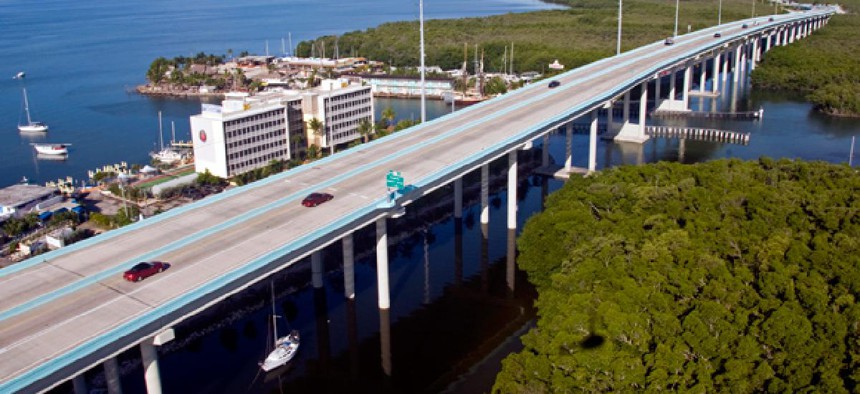
Andy Newman, Florida Keys News Bureau/AP
The End of Federal Transportation Funding as We Know It
The diminishing power of the gas tax has renewed debate about how — and even whether — Washington can pay for local roads and rails.
This month marks 120 years since the federal government got involved in funding road transportation. (Strange as it sounds, bicycle advocates did the bulk of the lobbying.) The original Office of Road Inquiry — today, the Federal Highway Administration — was a line item with a budget of $10,000. That was only enough money to build about three miles of road, and the office wasn't empowered to build roads anyway, but states fought tooth and nail against giving the feds even this incredibly modest level of transport oversight.
Today the federal transportation program faces perhaps its greatest challenge since that shaky start. The most urgent problem is funding. The Highway Trust Fund that pays for America's road and rail program is heading straight toward bankruptcy. For two decades politicians have refused to raise the 18.4-cents-per-gallon gas tax that populates the trust, even as it steadily loses purchasing power to inflation and fuel-efficient cars. The public has yet to embrace alternative funding sources — road fares or mileage fees on the user-pay side favored by economists; income taxes on the social welfare end — in part because people (mistakenly) believe they already pay a lot for transportation.
Money is only part of the problem. The other big sticking point is purpose. There's no longer a clear priority for national transport investment like there was during the heyday (or, rather, hey-half century) of the interstate highway program. Maintaining existing roads lacks the ribbon-cutting appeal of opening new ones. The closest thing to a new national initiative is a high-speed rail program, but while regional lines will no doubt emerge in dense corridors like California and the Northeast, political support for a national bullet train network is, to be generous, rather tepid. Lawmakers can barely muster the energy to pay for the rail system America already has, let alone a brand new one.
At stake is the very nature of America's top-down system of surface transportation funding. Confronted with these obstacles, officials and experts have intensified the debate over what role the federal government will play in funding transportation. Many are wondering, just as they did 120 years ago, whether there should be a federal role at all.
NEXT STORY: Open Government Group Gives Obama a Mixed Report






